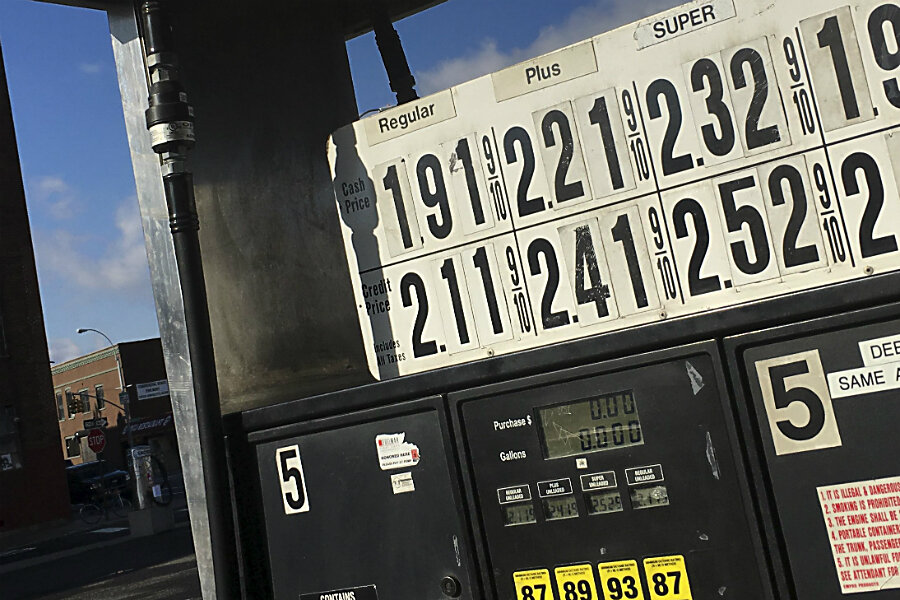Gas prices: How low will they go?
Loading...
| Washington
Drivers who hit the road during the Martin Luther King, Jr. holiday weekend spent less for gasoline than at any time in nearly seven years, and industry experts predict that prices at the pump haven't bottomed out yet.
The national average price of gasoline has dropped 7.6 cents in the past week to $1.89 a gallon, according to GasBuddy.com, a website that tracks real-time national gas prices. That is the lowest price per gallon since March 2009.
Gas price declines were posted in 48 states, with pump prices in only Iowa and Nebraska starting the week off higher.
“Motorists can expect gasoline prices to continue to decline in most areas over the next week as gas stations continue to pass along decreases in wholesale prices,” writes Patrick DeHaan, GasBuddy’s head petroleum analyst.
A glut of crude oil on world markets has been pushing down the price of oil products, including gasoline. By some estimates, the US inventory of crude oil is at its highest level in 80 years.
“Major producers are currently delivering 2 [million] to 2.5 million [barrels per day] more than demand, so the question is how long they can continue to overproduce at that level,” HSBC group chief executive Stuart Gulliver said Monday at the Asia Financial Forum in Hong Kong, as reported by Reuters.
The amount of excess oil sloshing around world markets is expected to increase as a result of the United States and the European Union lifting sanctions on Iran on Saturday. Those sanctions had cut Iran’s oil exports by about 2 million barrels a day. On Monday, crude from North Sea sources hit $27.67 in early trading, Reuters reported – the lowest price for Brent crude since 2003. US crude was also near its 2003 lows.
In the face of continuing excess crude supplies, average US gasoline prices for 2016 are expected to fall for the fourth consecutive year. The US government’s Energy Information Administration (EIA) forecasts that the retail price of regular gas will average $2.03 per gallon in 2016 and $2.21 in 2017. That compares with $2.43 a gallon in 2015.
In a report earlier this month, the EIA said it expects monthly retail prices to hit a seven-year low of $1.90 a gallon in February before rising in the spring.
GasBuddy projects the average US gas price for the year will be $2.28 a gallon. This would mean that collectively, consumers would be on track to spend roughly $17 billion less on gasoline than they did last year. And consumer spending on gas in 2015 was already $134 billion below gas costs in 2014.
Mr. DeHaan cautions that “forecasting gasoline and market fundamentals are a delicate blend of art and science.” Factors that could change the consumer-friendly forecast include a decision by major OPEC nations like Saudi Arabia or the United Arab Emirates to cut production of crude oil, problems that take major US refineries off-line, and supply disruptions during the hurricane season.
Whatever the national trend, gasoline prices vary based on local market factors. As a result of a price war, Michigan became the first state to report gas prices below $1 per gallon. One station in Houghton Lake, Mich., was selling gasoline over the weekend for 78 cents a gallon, while another posted a price of 95 cents, GasBuddy reported.
Consumers clearly benefit from lower gasoline prices, since less of the average household budget goes to fuel costs. AAA estimates that Americans last year saved an average of more than $550 per driver, when compared with 2014.
But gains for consumers are offset by the impact that falling oil revenues have on the budgets of energy-producing states like Alaska, Texas, Oklahoma, and North Dakota. Employees and shareholders of energy producers and suppliers, including firms like Chevron and BP, have also been hard hit.
As the year progresses, consumers should not expect gasoline prices to fall in a straight line. An Environmental Protection Agency-mandated annual transition from winter blend to summer blend fuel will produce rising prices this spring, writes DeHaan of GasBuddy. But the peak average price in April or May will be in the $2.70 per gallon zone, he says, versus the 2015 peak of $2.82.
The annual peak price also will vary widely by location, GasBuddy predicts. The peak daily average in Houston, the oil industry hub, is expected to be in the $2.30 to $2.50 per gallon range. In Los Angeles, the range is predicted to be $3.75 to $4.25.








